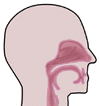  |
||
 |
Patients with congenital hyposmia have never experienced any smell function. However, in our program at The Taste and Smell Clinic in Washington, D.C., about half of the treated patients obtained some smell function. After receiving treatment with pharmacological therapy which stimulates growth and development of olfactory receptors, patients were able to detect and recognize many odors. The obtaining of the smell function has surprised many physicians since it is commonly believed that patients with congenital hyposmia have anatomical deficits that inhibit them from ever being able to smell. This may be true for Class I hyposmia patients, representing about 12% of the 400,000 patients in the US with congenital hyposmia, who do not commonly respond to drug or pharmacological treatment. Class II patients, who represent the other 88%, do respond to drug treatment which means that there is an intact olfactory system. Up to this point in time, there has been no definitive proof. In a series of elegant studies performed in association with Dr. Lucien Levy, Chief of Neuroradiology at GWUMC (the George Washington University Medical Center), we have demonstrated that there are specific neural connections between the olfactory bulb and the brain association centers dealing with olfaction in the temporal lobe of the brain. Through use of a novel program using MRI this neural connectivity can be traced anatomically from the bulb into various portions of the temporal lobe. The program for accomplishing this allows us to visualize these connecting pathways both in static and in video formats. Among Class II patients we demonstrated anatomically that (1) they have olfactory nerves, albeit small, (2) their brain activates to presented odors by use of functional magnetic resonance imaging (fMRI) techniques and (3) their anatomical brain regions involved with processing olfactory signals, while commonly distorted, are anatomically intact. However, no anatomical proof of the neural connectivity from olfactory bulb to olfactory association centers in the brain has been shown. This is the first anatomical demonstration of definitive neural connectivity in the olfactory system in which pathways from the olfactory bulb to associative brain centers dealing with olfaction in the temporal lobe have been defined. It is now clear that the olfactory system is intact among these patients and that appropriate pharmacological treatment can initiate smell function. These studies prove that in patients with Class II congenital hyposmia the olfactory system has been hard wired into the brain in utero, and the intact olfactory system is able to be utilized even after being “dormant” or unused from periods of 10-40 years. Home
| The Clinic | Diagnosis
| Treatment | FAQ
| Press
|
|